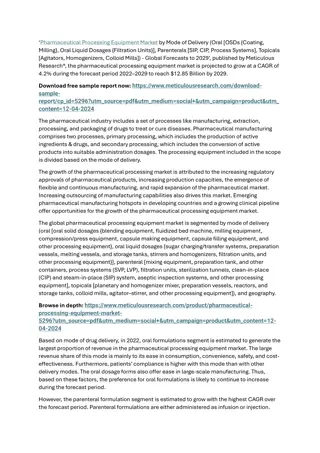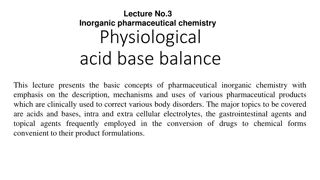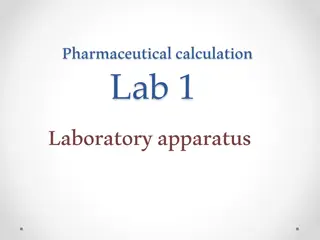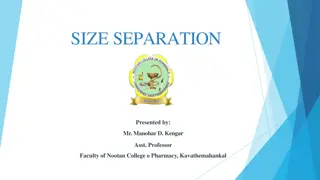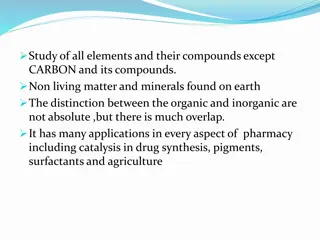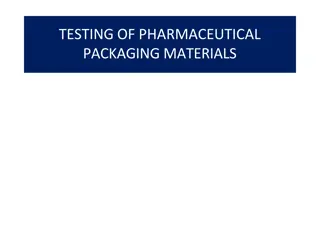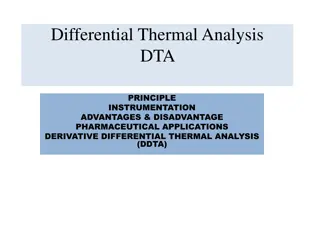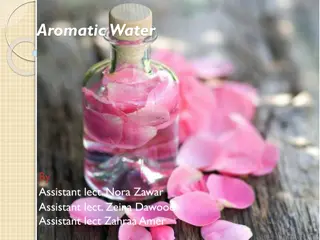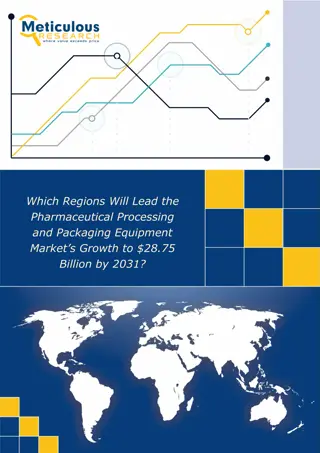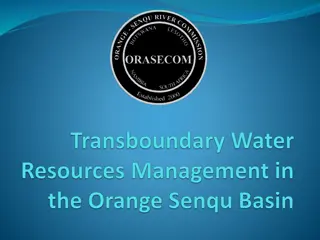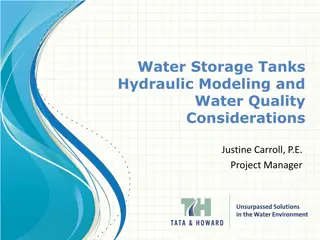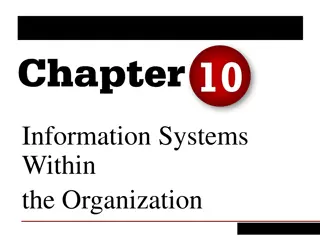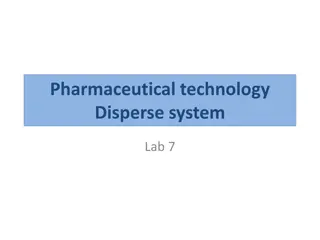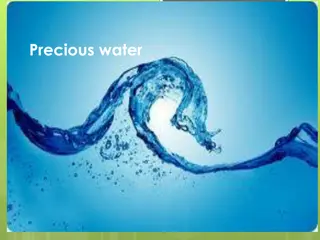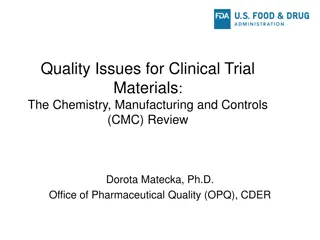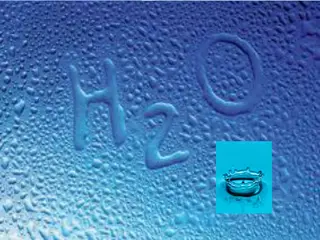Importance of Water Systems in Pharmaceutical Processing
Water is a critical raw material in biopharmaceutical processing, used for cell culture media, buffers, solvents, and cleaning. Purified water meeting pharmacopoeia standards is essential to prevent contamination in pharmaceutical manufacturing. Potable water is safe for drinking, while non-potable water carries health risks due to potential contaminants.
Download Presentation

Please find below an Image/Link to download the presentation.
The content on the website is provided AS IS for your information and personal use only. It may not be sold, licensed, or shared on other websites without obtaining consent from the author. Download presentation by click this link. If you encounter any issues during the download, it is possible that the publisher has removed the file from their server.
E N D
Presentation Transcript
Water Systems in Pharmaceutical Processing
Water for Biopharmaceutical processing Water : One of the most important raw materials : used as a basic ingredient - Cell culture media, buffers, solvent in extraction and purification, solvent in preparation of liquid form and freeze-dried products - used for ancillary processes : cleaning - ~ 30,000 liters of water: - in production of 1 kg of a recombinant biopharmaceutical produced in a microbial system Generation of water of suitable purity: - Is central to successful operation of any facility
Water for Biopharmaceutical processing 2 Utility water is insufficient because it con tains: Salts, organic matter, particles, and microor ganisms that pollute or even destroy produc ts and processes. Water for the pharmaceutical industry m ust be of high quality and at the same ti me meet the regulatory requirements of the pharmacopeia governing the wa ter treatment equipment.
Purified water Prepared from potable water source Meet pharmacopoeia specification f or chemical and microbial purity Protected from recontamination Protected from microbial proliferatio n
Purified Water cont. Two levels of water quality : Purified water and WFI - Outlined in international pharmacopeias Use of purified water: Solvent in the manufacture of aqueous-based oral products - e.g., cough mixtures Primary cleaning of some process equipment/clean room floors Generation of steam in the facilities, autoclaves Cell culture media Water for injection (WFI) Highest purity Extensive use in biopharmaceutical manufacturing
Potable water Water that has been boiled, filtered, cleaned, or treated to meet the standards for drinking wate r meaning that it is reasonably clear of contaminants and harmful bacteria. Thereby, making the water safe for drinking and cooking.
Non-Potable water Non-potable water is raw water from ground wells springs, rivers or lakes that is not treated at all It is not safe to drink non-potable water as it could contain unknown contaminant s. Non-potable water may taste normal but it can carry health risks
Generation of Purified water and WFI Generated from potable water Potential impurities in potable water: Multi-step purification steps for purified water and WFI: Monitoring of each step: continuous measurement of the resistivity of the water Example: Deionization: anion/cation exchangers Filters to remove microorganisms: 0.22 m, 0,45 m Reverse osmosis (RO) membrane : Semi-permeable membrane (permeable to the solvent, water, but impermeable to solute, i.e., contaminants)
Osmosis Osmosis is a special case of diffusion in which the molecules are water and the concentration gradient occurs across a semipermeable membrane. The semipermeable membrane allows the passage of water, but not ions (e.g., Na+, Ca2+, Cl-) or larger molecules (e.g., glucose, urea, bacteria). Diffusion and osmosis favorable and will continue until equilibrium is reach ed. Osmosis can be slowed, stopped, or even reversed if sufficient pressure is applied to the membrane from the 'concentrated' side of the membrane. are thermodynamically
REVERSE OSMOSIS BASICS Osmosis is a natural phenomenon that provides water to all animal and vegetable cells to support life Water moves from a high concentration of water (less sugar/salt dissolved in it) to a low concentration of water ( more salt/sugar dissolved in it) across a semi-permeable membr ane This means that water can cross a selectively permeable membrane from a dilute solution (less dissolved in it) to a concentrated solution (more dissolved in it)
Reverse Osmosis Reverse osmosis occurs when the water is moved across the membrane against the concentration gradient, from higher concentration to lower conce ntration. To illustrate, imagine a semipermeable membrane with fresh water on one side and a concentrated aqueous solution on the other side. If normal osmosis takes place, the fresh water will cross the membrane to dilute the concentrated solution. In reverse osmosis, pressure is exerted on the side with the concentrated solution to force the water molecules across the membrane to the fresh water side.
Reverse Osmosis continued. Reverse Osmosis Membrane: The Reverse Osmosis Membrane is the heart of the system. The most commonly used is a spiral wound Two options: the CTA (cellulose tri-acetate), which is chlorine tolerant, the TFC/TFM (thin film composite/material), not chlorine tolerant. Post filter (s): After the water leaves the RO storage tank, but before going to the RO faucet, the product water goes through the post filter (s). The post filter(s) is generally carbon (either in granular or carbon bloc k form). Any remaining tastes and odors are removed from the product water by post filtration.
RO Advantages Friendly to the environment, Do not produce or use any harmful chemicals during the process. Require a minimal amount of power. Taste of the purified water is a distinct advantage. Reverse osmosis removes dissolved minerals and other conta minants that cause water to smell unpleasant, taste poor ly and take on unusual colors Removal of dissolved minerals, metals and other particles ben efits plumbing systems. There is nothing in the water to corrode pipes or collect as s ediment
Disadvantages Reverse osmosis treatments require an enormous amount of wat er. Such systems typically return as little as 5 to 15 percent of the water pushed through the system, which means it also takes a long time to properly treat the water. This amount of wastewater can burden home septic systems. Water entering the reverse osmosis system should also be free of bacteria. While reverse osmosis systems do remove nearly all microorgani sms the risk of contamination through tiny leaks or deteriorating parts prevents reverse osmosis systems from being used to remove bacteria
Reverse osmosis applications Sea Water Desalination Pharmaceutical Water Purification Bottled Water Production Waste Water Recycling Car washes Spot Free rinse Medical Device Manufacturing Rural Water purification Brackish Well Water Desalination Laboratory Water Purification Food Products and Cosmetic Products Industrial Water Purification
Demineralisation All natural waters contain, in various concentrations, dissolved salts which dissociate in water to form charged ions. Positively charged ions are called cations; Negatively charged ions are called anions. Ionic impurities can seriously affect the reliability and operating efficiency of a boiler or process system. Overheating caused by the build-up of scale or deposits formed by these im purities can lead to: catastrophic tube failures, costly production losses, and unscheduled downtime. Hardness ions, such as calcium and magnesium, must be removed from t he water supply before it can be used as boiler feed water. For high-pressure boiler feed water systems and many process systems, nearly complete removal of all ions, including carbon dioxide and silica, i s required. Ion exchange systems are used for efficient removal of dissolved ions from wa ter.
Water system requirements Monitoring of water sources Chemical and microbiological Endotoxin level (where relevant) Monitoring of system performance, stora ge and distribution systems Records of results, and action taken Validated sanitization procedure followed on a routine basis
Highly Purified Water (HPW) Prepared from potable water source Prepared by combination of method s Reverse osmosis (RO), Ultrafiltration (UF) Deionization (DI)
Water For Pharmaceutical Use (WPU) Suitable materials include: Stainless steel (Low carbon Grade) Polypropylene (PP) Polyvinylidenedifluoride (PVDF) Perfluoroalkoxy (PFA)
Bio-contamination control techniques Periodic sanitization with hot water Periodic sanitization with super-heated hot water or clean steam Reliable Monitoring temperature during cycle Routine chemical sanitization Removal of sanitizing agent before use of water important
Pipes and Pumps Pipes and pumps hygienic couplings welded pipes hygienic pumps hygienic sampling points acceptable floor no leaks
WPU Water: Documentation to review: Qualification protocols and reports Change control request (where applicable) Requalification (where applicable) QC and microbiology laboratory: SOP for sampling Procedures and records
WPU cont. Sampling There must be a sampling procedure Sample integrity must be assured Sampler training Sample point Sample size
WPU: Water Testing Review method verification Chemical testing Microbiological testing Test method Types of media used Incubation time and temperature Objectionable organisms Must set specifications





